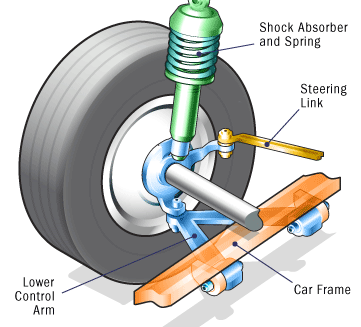|
When people think of automobile performance, they normally think of horsepower , torque and zero-to-60 acceleration. But all of the power generated by a piston engine is useless if the driver can't control the car. That's why automobile engineers turned their attention to the suspension system almost as soon as they had mastered the four-stroke internal combustion engine.

The job of a car suspension is to maximize the friction between the tires and the road surface, to provide steering stability with good handling and to ensure the comfort of the passengers. In this article, we'll explore how car suspensions work, how they've evolved over the years and where the design of suspensions is headed in the future.
If a road were perfectly flat, with no irregularities, suspensions wouldn't be necessary. But roads are far from flat. Even freshly paved highways have subtle imperfections that can interact with the wheels of a car. It's these imperfections that apply forces to the wheels. According to Newton's laws of motion, all forces have both magnitude and direction . A bump in the road causes the wheel to move up and down perpendicular to the road surface. The magnitude, of course, depends on whether the wheel is striking a giant bump or a tiny speck. Either way, the car wheel experiences a vertical acceleration as it passes over an imperfection.

Without an intervening structure, all of wheel's vertical energy is transferred to the frame, which moves in the same direction. In such a situation, the wheels can lose contact with the road completely. Then, under the downward force of gravity , the wheels can slam back into the road surface. What you need is a system that will absorb the energy of the vertically accelerated wheel, allowing the frame and body to ride undisturbed while the wheels follow bumps in the road.
.gif)
The study of the forces at work on a moving car is called vehicle dynamics , and you need to understand some of these concepts in order to appreciate why a suspension is necessary in the first place. Most automobile engineers consider the dynamics of a moving car from two perspectives:

- Ride - a car's ability to smooth out a bumpy road
- Handling - a car's ability to safely accelerate, brake and corner
These two characteristics can be further described in three important principles - road isolation , road holding and cornering . The table below describes these principles and how engineers attempt to solve the challenges unique to each.
A car's suspension, with its various components, provides all of the solutions described.
Let's look at the parts of a typical suspension, working from the bigger picture of the chassis down to the individual components that make up the suspension proper.
Car Suspension Parts
The suspension of a car is actually part of the chassis, which comprises all of the imp ortant systems located beneath the car's body.
These systems include:
- The frame - structural, load-carrying component that supports the car's engine and body, which are in turn supported by the suspension
- The suspension system - setup that supports weight, absorbs and dampens shock and helps maintain tire contact
- The steering system - mechanism that enables the driver to guide and direct the vehicle
- The tires and wheels - components that make vehicle motion possible by way of grip and/or friction with the road
So the suspension is just one of the major systems in any vehicle.
With this big-picture overview in mind, it's time to look at the three fundamental components of any suspension: springs, dampers and anti-sway bars.
Springs
Today's springing systems are based on one of four basic designs:
- Coil springs - This is the most common type of spring and is, in essence, a heavy-duty torsion bar coiled around an axis. Coil springs compress and expand to absorb the motion of the wheels.
|



